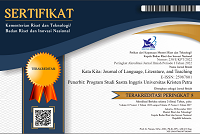Politeness Strategies Portrayed in Peaky Blinders Series
DOI:
https://doi.org/10.9744/katakita.13.2.239-245Abstract
This qualitative study aims to find the correlation between politeness strategies and status scale when Thomas Shelby communicates to Billy Kimber, a high-status person, and to Chester Campbell, an equal-status person, in a negotiation situation by using Brown and Levinson’s (1987) politeness strategy theory and Holmes’ (2013) social dimensions theory. The source of data is the Peaky Blinders series, season 1 episode 2, and the data are Thomas Shelby’s utterances that contain politeness strategies to Billy Kimber and to Chester Campbell. The findings show that Thomas Shelby often uses negative politeness to Billy Kimber and does not use it at all to Chester Campbell. In addition, Thomas Shelby often uses one of the bald on record types to Chester Campbell compared to Billy Kimber. This study concludes that Thomas Shelby does not carelessly use politeness strategies when negotiating. Instead, Thomas Shelby considers his interlocutor's social status to choose the proper politeness strategies when negotiating. As for the future studies, the writer suggests other researchers to examine scenes other than negotiations or to identify other subjects in this series.
Downloads
Published
Issue
Section
License
Authors who publish with this journal agree to the following terms:- Authors retain copyright and grant the journal right of first publication with the work simultaneously licensed under a Creative Commons Attribution License that allows others to share the work with an acknowledgement of the work's authorship and initial publication in this journal.
- Authors are able to enter into separate, additional contractual arrangements for the non-exclusive distribution of the journal's published version of the work (e.g., post it to an institutional repository or publish it in a book), with an acknowledgement of its initial publication in this journal.
- Authors are permitted and encouraged to post their work online (e.g., in institutional repositories or on their website) prior to and during the submission process, as it can lead to productive exchanges, as well as earlier and greater citation of published work (See The Effect of Open Access).














